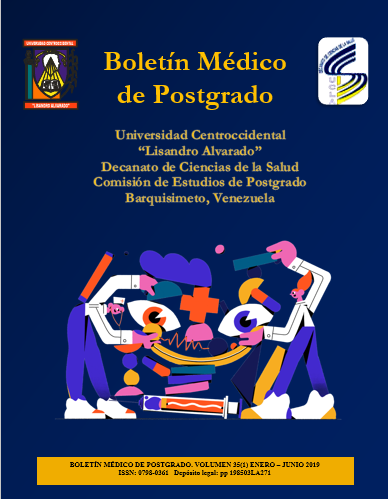Characterization of the Guillain-Barré syndrome in pediatric patients
Keywords:
polyrradiculoneuropathy, flacid paralysis, demielinization, arreflexiaAbstract
Guillain Barré Syndrome (GBS) is characterized by acute or subacute manifestation of peripheral nervous system alterations such as flaccid paralysis and arreflexia, which can eventually be life-threatening and/or become chronic if specific treatments are not established in a timely manner. The main causes of GBS are attributed to infectious agents which trigger an autoimmune response that affect both the myelin and the axon. GBS is the most frequent cause of flaccid paralysis in the pediatric population. The present investigation characterized the GBS in patients admitted to the Servicio Desconcentrado Hospital Pediátrico Dr. Agustín Zubillaga in the period 2010 to 2016.
Downloads
References
2. Hauser S, Amato A. (2012). Síndrome de Guillain-Barré y otras neuropatías mediadas por mecanismos inmunitarios en: Longo D, Loscalzo J, et al. Harrison Principios de Medicina Interna. Mc Graw Hill. 18ª Edición.
3. González Mata, A, Arias I, et al (1995). Síndrome de Landry Guillain Barré Strohl: 63 casos en menores de 13 años .Hospital Central Antonio María Pineda, Barquisimeto, Venezuela. Mayo 1982 a Febrero 1992. Boletín Médico de Postgrado UCLA V. 11 N. 02 ABRIL-JUNIO 1995 [Documento en línea] Disponible en: http://bibvirtual.ucla.edu.ve/db/psm_ucla/edocs/bm/BM1102/BM110205.pdf [Consulta: 2017, Junio 03].
4. Fokke C, Bart C. Diagnosis of Guillain-Barré syndrome and validation of Brighton criteria. Brain 2014; 137: 33–43.
5. Parra B, Pardo C, et al. Guillain–Barré Syndrome Associated with Zika Virus Infection in Colombia. N Engl J Med 2016; 375: 16.
6. Pérez Guirado A, De Juan Frigola J. Síndrome de Guillain Barré. Protocolos de Neurología. Bol Pediatr 2006; 46(1):49-55
7. Maneesh K, et al. Guillain-Barré Syndrome: A Clinical Study of Twenty Children. Journal of Clinical and Diagnostic Research 2015; 9(1): SC09-SC12.
8. Abdelrahim S, Wafaa A, et al. Outcome of Guillain - Barré Syndrome in Children: A prospective cohort study in a tertiary hospital in Upper Egypt. Electronic Physician 2016; 8(12): 3318-3324.
9. Uzcátegui A, et al. Síndrome de Landry Guillain Barré Strohl en el Hospital Pediátrico Agustín Zubillaga de Barquisimeto. Archivos Venezolanos de Puericultura y Pediatría 2006; 69(2): 60-66.
10. Fejerman N, Fernández E. (2007). Neurología Pediátrica. Tercera Edición. Editorial Médica Panamericana.
11. Orkun T, Abdurrahman S, et al. Concurrency of Guillain-Barre syndrome and acute transverse myelitis: a case report and review of literature. Korean J Pediatr 2016; 59(1):S161-164.
12. López-Esteban P, GIL V, et al. Criterios neurofisiológicos en el síndrome de Guillain-Barré infantil. Ocho años de experiencia. Rev Neurol 2013; 56 (5): 275-282.
13. San Juan D, et al. Síndrome de Guillain Barré secundario a meningoencefalitis. Reporte de caso. Arch Neurocien (Mex) 2015; 20(3): 217-220.
Published
How to Cite
Issue
Section
Las opiniones expresadas por los autores no necesariamente reflejan la postura del editor de la publicación ni de la UCLA. Se autoriza la reproducción total o parcial de los textos aquí publicados, siempre y cuando se cite la fuente completa y la dirección electrónica de esta revista. Los autores(as) tienen el derecho de utilizar sus artículos para cualquier propósito siempre y cuando se realice sin fines de lucro. Los autores(as) pueden publicar en internet o cualquier otro medio la versión final aprobada de su trabajo, luego que esta ha sido publicada en esta revista.



